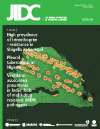Antimicrobial susceptibility patterns of community-acquired uropathogens in Tehran, Iran
DOI:
https://doi.org/10.3855/jidc.540Keywords:
Urinary tract infection, antimicrobial susceptibility, uropathogensAbstract
Background: Antibiotic resistance of urinary tract pathogens has increased worldwide. Knowledge of the antibiotic resistance patterns of uropathogens in specific geographical locations is an important factor for choosing an appropriate empirical antimicrobial treatment. The aim of this study was to provide information regarding local resistance patterns of urinary pathogens to the commonly used antibiotics in Tehran, Iran.
Methodology: Urine samples collected and submitted to two pathobiology laboratories in Tehran were identified by conventional methods over a period of three years (December 2006 to May 2009). Antimicrobial resistance testing was performed by the standard disk diffusion technique in accordance with the recommendations of the Clinical and Laboratory Standards Institute.
Results: Of the total 13,333 mid-stream urine samples collected from suspected cases of urinary tract infection, 840 (6.3%) were positive for pathogenic bacteria. Escherichia coli (E. coli) was the most common isolate (68.8%) followed by Proteus spp. (12.4%), and Klebsiella spp. (9.6%). E. coli isolates were mostly susceptible to nitrofurantoin (71.3%), followed by ciprofloxacin (68.1%); however, only 38.2% of E. coli isolates were susceptible to trimethoprim-sulfamethoxazole.
Conclusion: Nitrofurantoin may be considered as a first-line empiric antibacterial agent for urinary tract infections in outpatients in Tehran, Iran.
Downloads
Published
How to Cite
Issue
Section
License
Authors who publish with this journal agree to the following terms:
- Authors retain copyright and grant the journal right of first publication with the work simultaneously licensed under a Creative Commons Attribution License that allows others to share the work with an acknowledgement of the work's authorship and initial publication in this journal.
- Authors are able to enter into separate, additional contractual arrangements for the non-exclusive distribution of the journal's published version of the work (e.g., post it to an institutional repository or publish it in a book), with an acknowledgement of its initial publication in this journal.
- Authors are permitted and encouraged to post their work online (e.g., in institutional repositories or on their website) prior to and during the submission process, as it can lead to productive exchanges, as well as earlier and greater citation of published work (See The Effect of Open Access).








